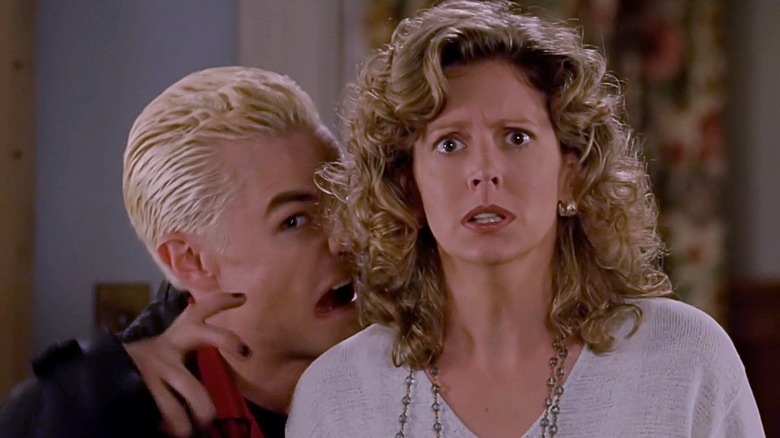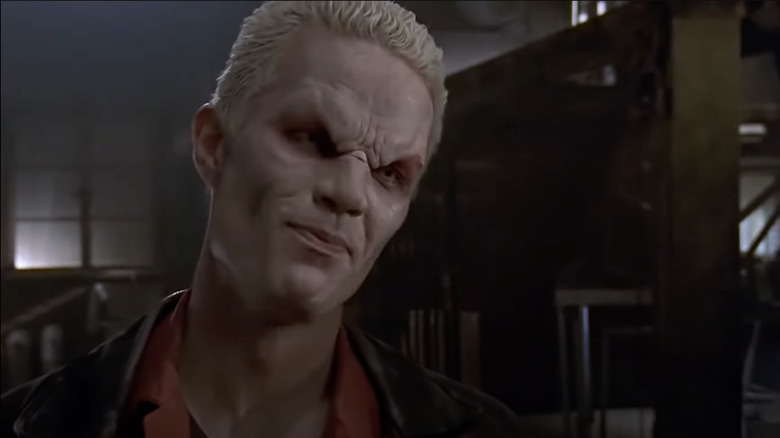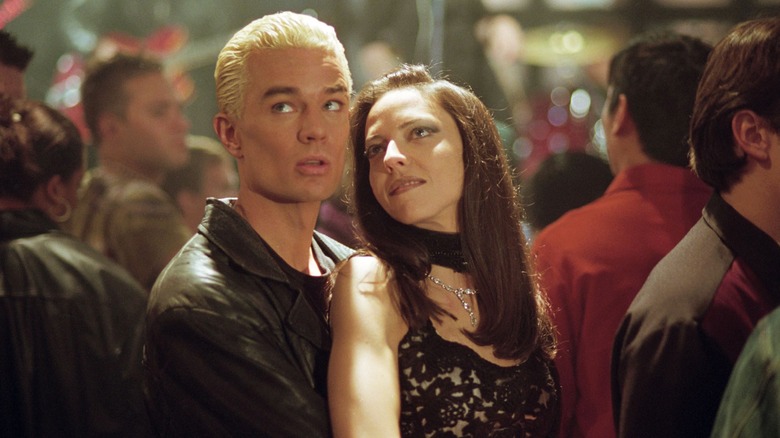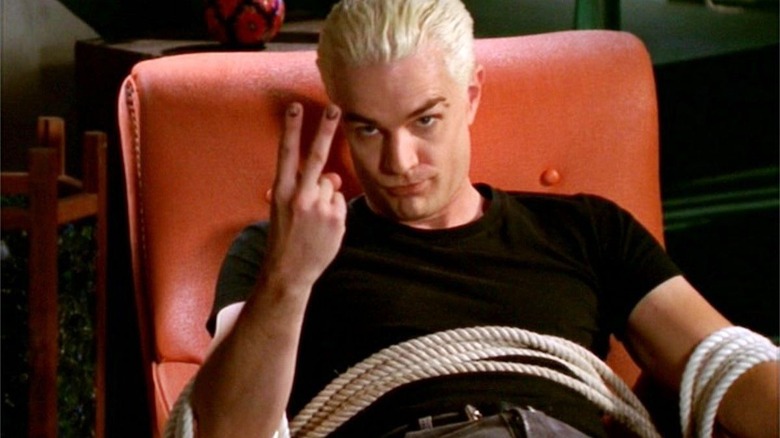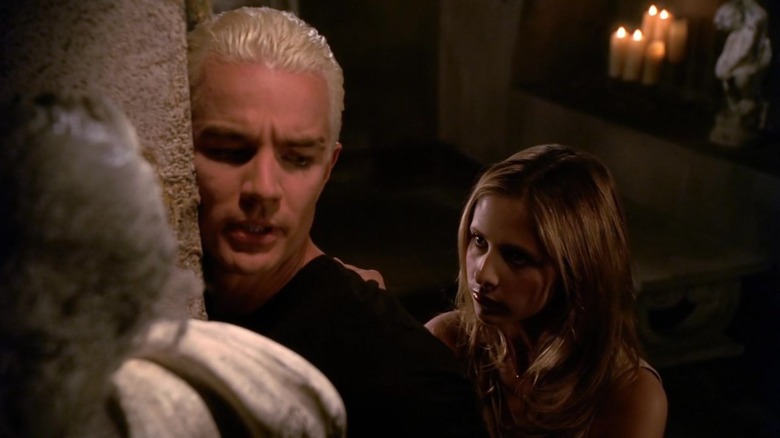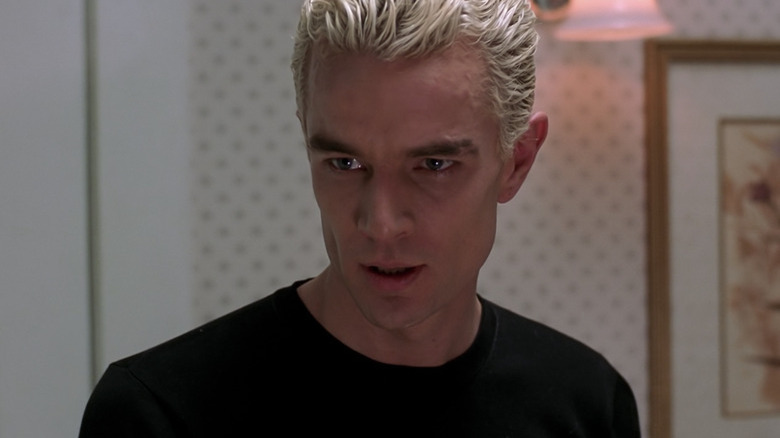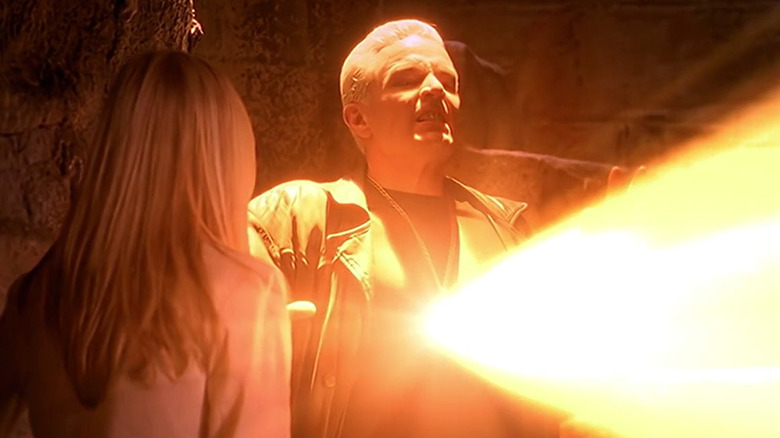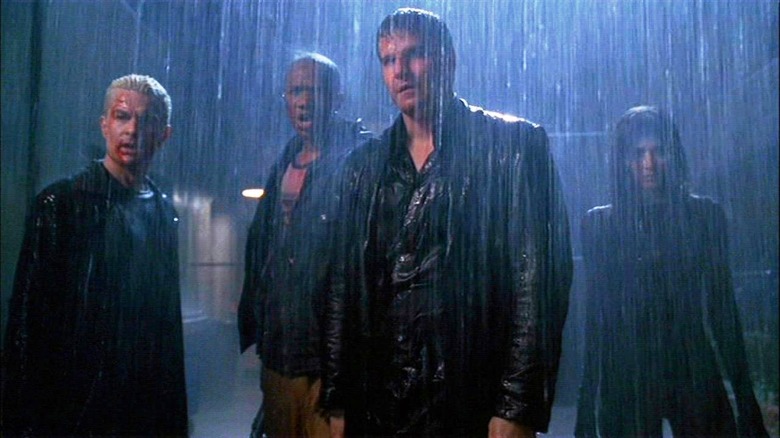James Marsters Says Buffy The Vampire Slayer Writers 'Never Really Knew What To Do With Spike'
This article contains references to sexual assault.
It's been 20 years since "Buffy the Vampire Slayer" concluded and no character went on a more transformative journey than Spike (James Marsters). Blond, British, and rarely without his black leather duster or a clever insult, Spike was half Billy Idol, half Nancy Spungen, and all vampire. Introduced in season 2, he wound up stealing the show, going from Buffy's enemy to ally of convenience to lover. Spike's development hadn't been intended from the outset; he was introduced as a villain and meant to die quickly after as one. Yet, fans loved him so much that keeping him around became a necessity.
Marsters spoke at length about his "Buffy" experience to Radio Times. He admits that the show's writers "never knew what to do with" his character, because Spike's sexy swagger undermined the story's themes:
"'Buffy' is not an Anne Rice kind of thing, where you're supposed to feel for the vampires. It's why we're hideously ugly when we bite someone, they did not want that to be a sensual kind of thing. It was supposed to be horrific."
There was already one goody-two-shoes vampire on the cast, though: Angel (David Boreanaz). When he left for a spin-off at the end of season 3, that created an opening for Spike to come back full-time. Now the writers had the conundrum of justifying his presence.
"They were always like, coming to me at the beginning of every season saying, 'We don't know what to do with you! We have a plan for the season, we have a plan for all the other characters, we have all the arcs of all the other characters, we just don't know what to do with you again.'"
Hence, Spike essentially went through a different phase every season he was in.
Why Spike was a problem
Spike is introduced in "Buffy" season 2, episode 3 — "School Hard." He comes to Sunnydale because he believes the Hellmouth can heal the sickly Drusilla (Juliet Landau), his girlfriend and the brunette Sid to his Nancy. Spike was originally supposed to be in only five episodes and then die at the end of the mid-season two-parter, "What's My Line." This would pave the way for the soon-to-be de-souled Angel to take his place as the Big Bad. But that's not what happened.
Marsters has attested several times that Spike's popularity irritated series creator Joss Whedon. On Michael Rosenbaum's podcast "Inside of You," Marsters revealed that Whedon backed him against a wall and told him, "'I don't care how popular you are, kid, you're dead. You hear me? Dead. Dead!'" It's come to light that such abuse isn't out of character for Whedon.
In a later appearance on "Inside of You," Marsters explained:
"In Joss' world, evil is not cool and I really respect him for that. Vampires were a metaphor for the challenges you get over in your adolescence, so vampires are overcome ... [Spike's continued presence] is going to change the show from a teenager overcoming adolescence into a show where those problems are kind of sexy ... I was killing people all the time, I was shredding them, and the audience was going, 'Oh we want more of that.'"
Even a writer with an ego like Whedon's sometimes has to bow to network and audience demands.
Saving Spike
Marsters told both Rosenbaum and Radio Times that if he'd been in Whedon's shoes, he would've killed Spike off. He detailed to the latter:
"If it had been me producing that show, I would have killed Spike off in a heartbeat. As soon as the audience said, 'Oh, we want him. Oh, have him with Buffy. Oh, we love that character.' Like, uh-uh. He's ruining the whole thing. I would have killed me off after probably three episodes. I'm kind of a b*****d when I'm producing! I'm heartless! So I'm very lucky that they had more imagination and courage than I would have shown, frankly."
So instead, "What's My Line" ends with a church collapsing on Spike before he's rescued by the healed Drusilla. Spike is confined to a wheelchair and spends episodes festering over Angel stealing the spotlight and his girl. In the finale, once he's healed, he teams up with Buffy to foil Angel then escapes Sunnydale with an unconscious Dru. Spike wouldn't be gone for long, though.
Spike returns for a one-off guest appearance in "Buffy" season 3, episode 8 "Lovers Walk." He arrives back in Sunnydale a drunken, weepy mess (Drusilla dumped him because saving the world is a turn-off). The episode is about Spike getting his mojo back and ends with him driving out of town again, rocking out to the Sex Pistols cover of "My Way." In other words, not even approaching the road to redemption.
Deus Ex Chip
When Spike returned in season 4, the season's main villains — the demon-hunting Initiative — captured him and put a chip in his brain. Said chip caused him agonizing pain whenever he tried to hurt a human. Neutered as a threat, Spike had to throw in with Buffy and co. for any chance at survival.
Marsters wasn't a fan of this development; he described it as a "Deus Ex Chip" to Radio Times. However, this resulted in a Spike who was nominally on Buffy's side but still didn't like her. That, in turn, filled a hole in the show's character dynamics. Cordelia Chase (Charisma Carpenter), Sunnydale's resident mean girl, jumped ship to "Angel" after season 3. Per Marsters, this meant the show needed someone else who was willing to say, "'Sod off Buffy, you're stupid Buffy, we're all gonna die, Buffy.'" He was all too happy to fill that role, even if he had something different in mind for Spike.
The funniest episode of "Buffy" season 4 is "Something Blue," where a magical mishap from Willow (Alyson Hannigan) turns Buffy and Spike into a lovey-dovey couple. The point of the episode is to underline the absurdity of a romance between them — yet just one season later, such a thing was on the horizon. In season 5, Spike catches feelings for Buffy and goes from the grumpy complainer to a hopelessly smitten hanger-on.
Fool for Love
It's easy to think Spike falling in love with Buffy is inconsistent with his established character, but it's really not. From the beginning, Spike was a romantic. His relationship with Drusilla ran counter to the idea that vampires couldn't love. The season 5 episode "Fool for Love" revealed that Spike was an (awful) poet in life and he wound up sired because Drusilla was the only girl whose eye he could catch. Now we get to the contradiction: if Whedon hadn't intended Spike to be sexy, then he shot himself in the foot by writing him as a lover back in season 2.
Marsters felt Spike's crush was a better motive for his heel face turn than the chip, since it was emotionally honest and held loads of storytelling potential:
"If [Spike] fell in love with [Buffy], he could try to win her affection and fail over and over again, and you could do that in horrifying ways, you could do that in comedic ways, there's many different kinds of iterations that you could follow that kind of game plan on."
However, he still felt that the Slayer herself would "never" fall for Spike: "That would be ridiculous, I thought." Come season 6...
Seeing Red
Buffy dies in the season 5 finale, "The Gift." In the season 6 premiere, "Bargaining," she's resurrected by Willow. In-universe she spent five months dead, and so for most of season 6, Buffy is depressed and self-destructive — so much so she walks into Spike's arms and begins a sadomasochistic relationship with him.
Buffy breaks off the relationship once her friends find out about it. In "Seeing Red," Spike tries to convince her to take him back and refuses to accept "no," forcing Buffy to fight him off. Marsters called shooting that scene "the hardest day of my professional career," and said he needed therapy afterward. What brought about the scene? As Marsters explained, it came about because of how "Buffy the Vampire Slayer" was written:
"One of the reasons the Buffy writing was so good was that, to come up with an episode, the writers were being asked to come up with their worst day, the day that they don't talk about, the day that keeps them up at night, when they really got hurt or when they really hurt someone. And then, metaphorically speaking, slap fangs on top of their dark secret, write a story about it and let the whole world know about it."
"Seeing Red" was no different. A "Buffy" writer had once "thrown herself" at her boyfriend in a vain effort to stop a break-up; Spike attempting to rape Buffy was her writing about that "crushing experience" but "flipping the sexes."
The episode was also a last-ditch effort to convince the audience that Spike was, in fact, a bad guy. "They couldn't convince the audience to stop rooting for Spike," said Marsters. "They did not want the audience to say, 'Spike and Buffy forever,' that's just not what they were going for. They kept having me do worse and worse things trying to get people to realize."
In a bizarre twist, "Seeing Red" became the catalyst for Spike as a bona fide good guy. Realizing that he's hit rock bottom, Spike spends the rest of the season undergoing magical trials to regain his soul — and succeeds.
The end for Spike
In season 7 Spike is at his most mature. He and Buffy develop an actual, mutually-affectionate relationship. Take this frankly beautiful dialogue from "Touched," when Spike reassures Buffy:
"When I say 'I love you,' it's not because I want you or because I can't have you. It has nothing to do with me. I love what you are, what you do, how you try. I've seen your kindness and your strength. I've seen the best and worst of you. And I understand with perfect clarity exactly what you are. You're a hell of a woman. You're the one, Buffy."
Are these feelings reciprocated? According to Marsters, not quite.
"My favorite line, actually, is when [Buffy] says 'I love you' and [Spike] says, 'No, you don't. But thanks for saying it.' Because, for me, this is the first time that I thought Spike might really be able to redeem himself because he's basically saying, 'Buffy, you can't love me. You were right. I am beneath you. I have done horrible things. I have been a mass murderer, man. You're a hero. You can't love that.'"
In the "Buffy" finale, "Chosen," Spike gives his life to close the Hellmouth — he finally meets his fate 120 episodes late. Yet, it still wasn't the end. Spike was resurrected in the season 5 premiere of "Angel" and stayed on as a main cast member. At times, the series even started to feel like a buddy comedy between Angel and Spike. Oh, irony — Whedon didn't want vampires taking over his show, and then two vampires became the franchise's longest-lasting characters.
Spikeification
"Angel" season 1 aired concurrently with "Buffy" season 4. Just before Spike got chipped, he made a guest appearance on "Angel" episode 3, "In The Dark," as the villain of the week. He's introduced on a rooftop watching Angel rescue a woman and mockingly narrates: "I was once a badass vampire. But love, and a pesky curse, defanged me. Now I'm just a big fluffy puppy with bad teeth." One can only wonder if Spike later realized how prophetic those words were for him.
TV Tropes, the website that names and catalogs storytelling conventions, was created because of "Buffy" — the show arrived at the advent of the internet and its now irreplaceable role in fandom. One such trope is "Badass Decay," when a once cool and fierce character becomes less so over time. The original name for this trope? "Spikeification."
Evidently, some fans didn't appreciate Spike's character arc. Knowing that "Buffy" was actively trying to avoid "cool vampires" adds some perspective; if Spike was going to stay around, he couldn't be a villain anymore. Eventually, he would've been diminished as a threat if his plans kept failing and Buffy herself would look like an incompetent Slayer if she didn't stake him. That meant the writers had to experiment with Spike, even if he lost some of his original personality along the way.
Marsters summed up Spike's character as thus to Radio Times:
"I was the villain, and then I was the wacky neighbor, and then I was the wrong boyfriend, and then I was the fallen man trying to redeem himself. And then ultimately a kind of guinea pig hero by the end."
It's not the cleanest written redemption arc ever, but it's a character journey like no other and proof that growth can come from unexpected places.
"Buffy The Vampire Slayer" is streaming on Hulu.
